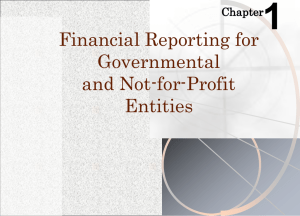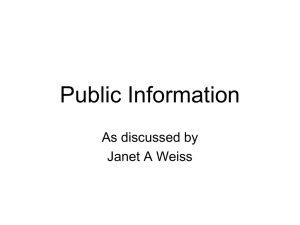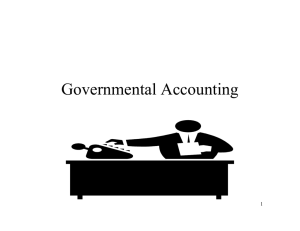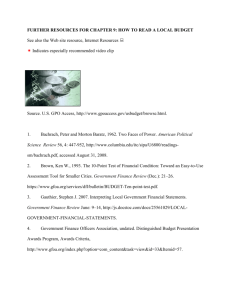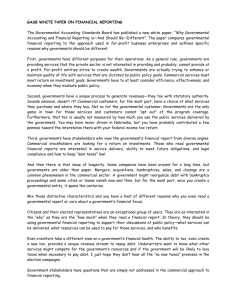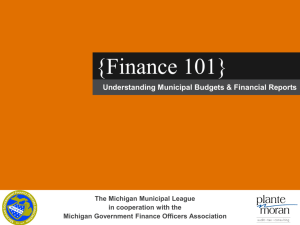FREE Sample Here
advertisement
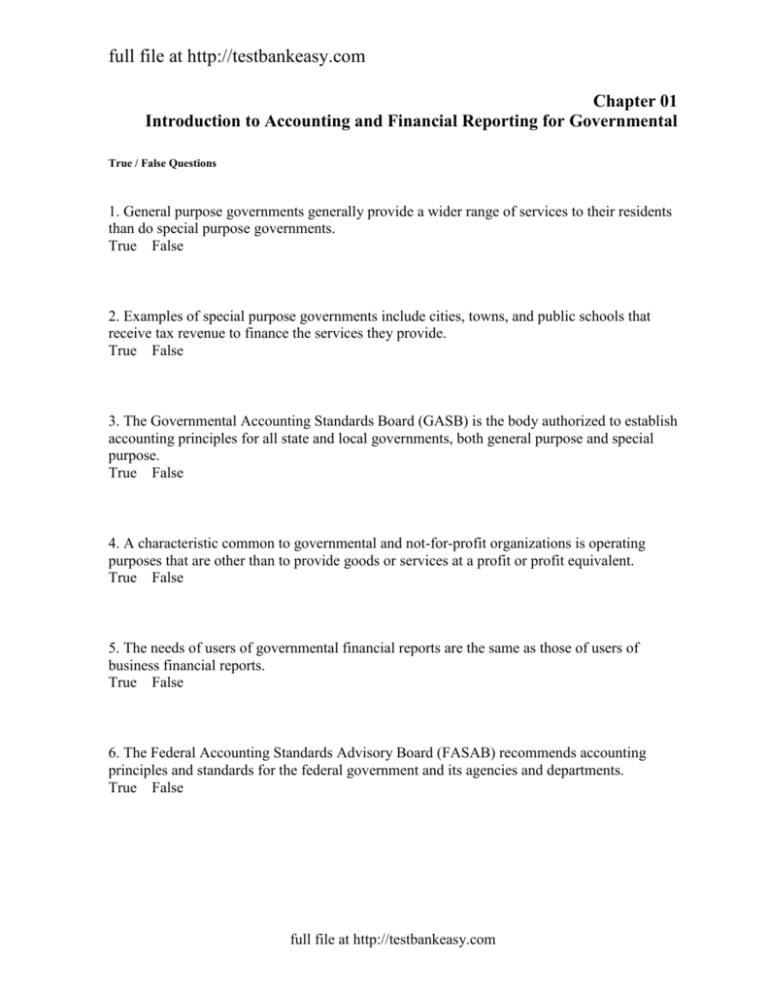
full file at http://testbankeasy.com Chapter 01 Introduction to Accounting and Financial Reporting for Governmental True / False Questions 1. General purpose governments generally provide a wider range of services to their residents than do special purpose governments. True False 2. Examples of special purpose governments include cities, towns, and public schools that receive tax revenue to finance the services they provide. True False 3. The Governmental Accounting Standards Board (GASB) is the body authorized to establish accounting principles for all state and local governments, both general purpose and special purpose. True False 4. A characteristic common to governmental and not-for-profit organizations is operating purposes that are other than to provide goods or services at a profit or profit equivalent. True False 5. The needs of users of governmental financial reports are the same as those of users of business financial reports. True False 6. The Federal Accounting Standards Advisory Board (FASAB) recommends accounting principles and standards for the federal government and its agencies and departments. True False full file at http://testbankeasy.com full file at http://testbankeasy.com 7. The FASB, GASB, and FASAB all focus their standards on both internal and external financial reporting. True False 8. Interperiod equity refers to the concept that current-year revenues are sufficient to pay for services provided that year, so that future taxpayers will not be required to assume the burden for services previously provided. True False 9. The minimum requirements for general purpose external financial reporting are (1) management's discussion and analysis (MD&A), (2) the basic financial statements, including the notes to the financial statements, and (3) combining and individual fund financial statements. True False 10. The statement of net assets and the statement of activities are the two government-wide financial statements required by GASBS 34. True False 11. The governmental fund financial statements are intended to report on fiscal accountability. True False 12. The basis of accounting under which revenues are recognized when measurable and available for spending and expenses when resources are consumed is the modified accrual basis of accounting. True False full file at http://testbankeasy.com full file at http://testbankeasy.com Multiple Choice Questions 13. The Governmental Accounting Standards Board is assigned responsibility for setting accounting and financial reporting standards for A. Governments; such as federal agencies, states, cities, counties, villages, and townships. B. State and local government entities and governmentally-related units and agencies, such as utilities, authorities, hospitals, and colleges and universities. C. Not-for-profit organizations. D. State and local government and all not-for-profit organizations. 14. The body that has been established to recommend accounting and financial reporting standards for the federal government is the A. Financial Accounting Standards Board (FASB). B. Governmental Accounting Standards Board (GASB). C. Cost Accounting Standards Board (CASB). D. Federal Accounting Standards Advisory Board (FASAB). 15. The Financial Accounting Standards Board has the responsibility for setting accounting and financial reporting standards for A. All not-for-profit organizations that are nongovernmental and business entities. B. All special purpose governments. C. All not-for-profit organizations. D. All federal government agencies. full file at http://testbankeasy.com full file at http://testbankeasy.com 16. Which of the following distinguishes governments from nongovernmental not-for-profit organizations? A. Absence of profit motive. B. The power to enact and enforce a tax levy. C. Resource providers do not expect benefits proportional to the resources provided. D. Absence of a defined ownership interest that can be sold, transferred, or redeemed. 17. Which of the following is identified by the GASB as the "cornerstone" of all financial reporting in government? A. Understandability. B. Representational faithfulness. C. Accountability. D. Interperiod equity. full file at http://testbankeasy.com full file at http://testbankeasy.com 18. Which of the following organizations issue standards that are intended for both internal and external users of financial information? A. Federal Accounting Standards Advisory Board. B. Governmental Accounting Standards Board. C. Financial Accounting Standards Board. D. American Institute of CPAs. 19. All of the following characteristics may indicate that an organization is governmental in nature except: A. The organization is a public corporation or body corporate and politic. B. Popular election of officers or appointment of a controlling majority of the organization's governing board by officials of a state or local government. C. The organization is legally separate and its governing body has discretion to manage the organization's affairs without approval by a government. D. The power to enact and enforce a tax levy. 20. Which of the following is not an objective of financial reporting by state and local governments? A. To assist users in assessing the adequacy of systems and controls. B. To assist users in assessing financial condition and results of operations. C. To assist financial report users in comparing actual financial results with the legally adopted budget. D. To assist in determining compliance with finance-related laws, rules, and regulations. 21. Which of the following groups is considered a primary user of a state or local government's general-purpose external financial statements? A. Citizens. B. Managers and administrators. C. Employees. D. Special interest groups. full file at http://testbankeasy.com full file at http://testbankeasy.com 22. One of the minimum requirements for general purpose external financial reporting is (are): A. Management's discussion and analysis (MD&A). B. Consolidated financial statements. C. Other supplementary information, such as combining and individual fund statements. D. Statistical information. 23. A comprehensive annual financial report (CAFR) prepared in conformity with GASB recommendations should include which of the following sections? A. Letter of transmittal, MD&A, and financial. B. Introductory, financial, and statistical. C. Introductory, MD&A, and financial. D. Letter of transmittal, financial, and supplementary. 24. Which of the following would be included in a properly prepared comprehensive annual financial report (CAFR), but not in the minimum requirements for general purpose financial reporting specified by GASBS 34? A. Management discussion and analysis (MD&A). B. Government-wide financial statements. C. Notes to the financial statements. D. Combining and individual fund financial statements. 25. A statistical section should be included in A. A comprehensive annual financial report (CAFR). B. The basic financial statements. C. The notes to the financial statements. D. Required supplementary information, other than MD&A. 26. Which of the following would typically not be included in the introductory section of a comprehensive annual financial report? A. Title and contents page. B. Letter of transmittal. C. A description of the government. D. Summary of the government's current financial position and results of financial activities. full file at http://testbankeasy.com full file at http://testbankeasy.com 27. The section of the comprehensive annual financial report that presents tables and charts showing social and economic data in addition to financial trends, fiscal capacity, and operating information of the government is the: A. Introductory section. B. Management discussion and analysis section. C. Statistical section. D. Financial section. 28. Which of the following information should be included in the financial section of a comprehensive annual financial report? A. Transmittal letter. B. The basic financial statements, including notes thereto. C. Tables and charts showing demographic and economic data. D. A description of the government. 29. On what should the government-wide financial statements report? A. Net assets and results of financial operations of the government as a whole. B. Fiscal accountability. C. The cost of government services. D. Budgetary compliance. 30. The fund financial statements for governmental funds should include a A. Statement of cash flows. B. Statement of revenues, expenses, and changes in fund net assets. C. Balance sheet. D. Statement of activities. 31. On what should the governmental fund financial statements report? A. Net assets and results of financial operations of the government as a whole. B. Fiscal accountability. C. Operational accountability. D. Cost of government services. full file at http://testbankeasy.com full file at http://testbankeasy.com 32. Which of the following reconciliations is required in the basic financial statements of a state or local government? A. Total fund balances on the balance sheet—governmental funds to total governmental activities net assets on the government-wide statement of net assets. B. Total net assets on the statement of net assets—proprietary funds to total business-type activities net assets on the government-wide statement of net assets. C. Total net assets on the statement of fiduciary net assets to total fiduciary activities net assets on the government-wide statement of net assets. D. Total fund balances on the balance sheet—governmental funds to total changes in fund balances on the statement of revenues, expenditures, and changes in fund balances—governmental funds. 33. Which of the following types of organizations may be subject to FASB jurisdiction? A. A state hospital. B. A college or university. C. A public school district. D. A public sanitation district. 34. Members of the Governmental Accounting Standards Board are appointed by the: A. Financial Accounting Standards Board. B. Governmental Accounting Standards Board. C. American Institute of Certified Public Accountants. D. Financial Accounting Foundation. 35. The organization that designates which authoritative standard setting body is responsible for establishing accounting and financial reporting standards for particular kinds of organizations (e.g., federal, state, and local government, not-for-profit, and business organizations) is the: A. American Institute of Certified Public Accountants. B. Financial Accounting Foundation. C. Government Finance Officers Association. D. Association of Government Accountants. full file at http://testbankeasy.com full file at http://testbankeasy.com 36. Recognizing revenues when measurable and available for paying current obligations and expenditures when incurred describes which basis of accounting? A. Accrual. B. Modified accrual. C. Modified cash. D. Budgetary. 37. Enterprise funds are primarily distinguished from internal service funds by the: A. Type of customers they serve. B. Different basis of accounting they use. C. Different kinds of financial statements used to present their financial information. D. Different budgeting approaches used. Essay Questions 38. Explain the essential differences between general purpose and special purpose governments and give several examples of each. 39. Explain what distinguishes governmental not-for-profit organizations from nongovernmental, not-for-profit organizations. Why is such a distinction necessary? full file at http://testbankeasy.com full file at http://testbankeasy.com 40. Identify and explain the characteristics that distinguish governmental and not-for-profit entities from business entities. 41. GASB and FASB standards are concerned only with external financial reporting whereas FASAB standards are concerned with both internal and external financial reporting. Do you agree with this statement? Why or why not? 42. Why should persons interested in reading financial reports of governmental and not-for-profit entities be familiar with standards set by the GASB and FASB? 43. Explain in your own words why accountability is the cornerstone of all financial reporting in government. full file at http://testbankeasy.com full file at http://testbankeasy.com 44. In your own words state the primary uses the GASB believes external users have for financial reports of state and local governments. For contrast, state the uses the FASB believes external users have for the financial reports of not-for-profit organizations. 45. Describe the difference between a comprehensive annual financial report (CAFR) and the GASBS 34 financial reporting model for state and local governments. 46. Distinguish between combining financial statements of a governmental entity and basic financial statements. 47. What information is the Management Discussion and Analysis (MD&A) intended to provide? full file at http://testbankeasy.com full file at http://testbankeasy.com 48. Why is it necessary to reconcile total fund balances reported on the balance sheet—governmental funds to total net assets reported for governmental activities on the government-wide statement of net assets, and net changes in fund balances in fund balances—total governmental funds to the change in net assets reported for governmental activities on the government-wide statement of activities? full file at http://testbankeasy.com full file at http://testbankeasy.com Chapter 01 Introduction to Accounting and Financial Reporting for Governmental Answer Key True / False Questions 1. General purpose governments generally provide a wider range of services to their residents than do special purpose governments. TRUE Difficulty: Easy Question Type: Concept 2. Examples of special purpose governments include cities, towns, and public schools that receive tax revenue to finance the services they provide. FALSE Although many public school systems are special purpose government, cities and towns are general purpose governments. Difficulty: Medium Question Type: Concept 3. The Governmental Accounting Standards Board (GASB) is the body authorized to establish accounting principles for all state and local governments, both general purpose and special purpose. TRUE Difficulty: Easy Question Type: Concept full file at http://testbankeasy.com full file at http://testbankeasy.com 4. A characteristic common to governmental and not-for-profit organizations is operating purposes that are other than to provide goods or services at a profit or profit equivalent. TRUE This is one of the characteristics; others include receipt of significant amounts of resources from resource providers who do not expect to receive either repayment or economic benefits proportionate to the resources provided and absence of defined ownership interests that can be sold, transferred, or redeemed, or that convey entitlement to a share of a residual distribution of resources in the event of liquidation of the organization. Difficulty: Easy Question Type: Concept 5. The needs of users of governmental financial reports are the same as those of users of business financial reports. FALSE As discussed in Chapter 1, the GASB issued a white paper that articulates a number of reasons why the needs of users of governmental financial reports are unique and different from those of business report users. Difficulty: Easy Question Type: Concept 6. The Federal Accounting Standards Advisory Board (FASAB) recommends accounting principles and standards for the federal government and its agencies and departments. TRUE The FASAB is the standard setting body assigned responsibility for recommending accounting and reporting standards for the federal government and its agencies and departments. Their recommendations become standards upon approval by the three officials empowered by federal law to set standards—the Comptroller General, the Secretary of the Treasury, and the Director of the Office of Management and Budget. Difficulty: Easy Question Type: Concept full file at http://testbankeasy.com full file at http://testbankeasy.com 7. The FASB, GASB, and FASAB all focus their standards on both internal and external financial reporting. FALSE While it is true that the FASAB sets standards for both internal and external users of financial information, the FASB and GASB focus their standards only on external financial reporting. Difficulty: Medium Question Type: Concept 8. Interperiod equity refers to the concept that current-year revenues are sufficient to pay for services provided that year, so that future taxpayers will not be required to assume the burden for services previously provided. TRUE Interperiod equity is a significant part of accountability of the government to its taxpayers, both current and future. Difficulty: Easy Question Type: Concept 9. The minimum requirements for general purpose external financial reporting are (1) management's discussion and analysis (MD&A), (2) the basic financial statements, including the notes to the financial statements, and (3) combining and individual fund financial statements. FALSE Although the first two items listed are part of the minimum requirements, combining and individual fund statements are included in the typical comprehensive annual report (CAFR), but are not part of the minimum GAAP requirements for governmental financial reporting. Difficulty: Medium Question Type: Concept full file at http://testbankeasy.com full file at http://testbankeasy.com 10. The statement of net assets and the statement of activities are the two government-wide financial statements required by GASBS 34. TRUE In addition to these two statements, there are two required basic financial statements for governmental funds, three for proprietary funds, and two for fiduciary funds, as illustrated and described in chapter 1. Difficulty: Medium Question Type: Concept 11. The governmental fund financial statements are intended to report on fiscal accountability. TRUE The fund financial statements for governmental funds are focused on fiscal accountability, the remaining fund financial statements and the government-wide financial statements are intended to help users assess operational accountability. Difficulty: Medium Question Type: Concept 12. The basis of accounting under which revenues are recognized when measurable and available for spending and expenses when resources are consumed is the modified accrual basis of accounting. FALSE The statement is true regarding revenue recognition. However, under modified accrual, expenditures not expenses are recognized when incurred. Accrual accounting is the basis under which expenses are recognized as resources are consumed. Difficulty: Medium Question Type: Concept full file at http://testbankeasy.com full file at http://testbankeasy.com Multiple Choice Questions 13. The Governmental Accounting Standards Board is assigned responsibility for setting accounting and financial reporting standards for A. Governments; such as federal agencies, states, cities, counties, villages, and townships. B. State and local government entities and governmentally-related units and agencies, such as utilities, authorities, hospitals, and colleges and universities. C. Not-for-profit organizations. D. State and local government and all not-for-profit organizations. Difficulty: Easy Question Type: Concept 14. The body that has been established to recommend accounting and financial reporting standards for the federal government is the A. Financial Accounting Standards Board (FASB). B. Governmental Accounting Standards Board (GASB). C. Cost Accounting Standards Board (CASB). D. Federal Accounting Standards Advisory Board (FASAB). Difficulty: Easy Question Type: Concept 15. The Financial Accounting Standards Board has the responsibility for setting accounting and financial reporting standards for A. All not-for-profit organizations that are nongovernmental and business entities. B. All special purpose governments. C. All not-for-profit organizations. D. All federal government agencies. Difficulty: Easy Question Type: Concept full file at http://testbankeasy.com full file at http://testbankeasy.com 16. Which of the following distinguishes governments from nongovernmental not-for-profit organizations? A. Absence of profit motive. B. The power to enact and enforce a tax levy. C. Resource providers do not expect benefits proportional to the resources provided. D. Absence of a defined ownership interest that can be sold, transferred, or redeemed. Difficulty: Medium Question Type: Concept 17. Which of the following is identified by the GASB as the "cornerstone" of all financial reporting in government? A. Understandability. B. Representational faithfulness. C. Accountability. D. Interperiod equity. Difficulty: Easy Question Type: Concept 18. Which of the following organizations issue standards that are intended for both internal and external users of financial information? A. Federal Accounting Standards Advisory Board. B. Governmental Accounting Standards Board. C. Financial Accounting Standards Board. D. American Institute of CPAs. Difficulty: Easy Question Type: Concept full file at http://testbankeasy.com full file at http://testbankeasy.com 19. All of the following characteristics may indicate that an organization is governmental in nature except: A. The organization is a public corporation or body corporate and politic. B. Popular election of officers or appointment of a controlling majority of the organization's governing board by officials of a state or local government. C. The organization is legally separate and its governing body has discretion to manage the organization's affairs without approval by a government. D. The power to enact and enforce a tax levy. Difficulty: Medium Question Type: Concept 20. Which of the following is not an objective of financial reporting by state and local governments? A. To assist users in assessing the adequacy of systems and controls. B. To assist users in assessing financial condition and results of operations. C. To assist financial report users in comparing actual financial results with the legally adopted budget. D. To assist in determining compliance with finance-related laws, rules, and regulations. Difficulty: Medium Question Type: Concept 21. Which of the following groups is considered a primary user of a state or local government's general-purpose external financial statements? A. Citizens. B. Managers and administrators. C. Employees. D. Special interest groups. Difficulty: Easy Question Type: Concept full file at http://testbankeasy.com full file at http://testbankeasy.com 22. One of the minimum requirements for general purpose external financial reporting is (are): A. Management's discussion and analysis (MD&A). B. Consolidated financial statements. C. Other supplementary information, such as combining and individual fund statements. D. Statistical information. Difficulty: Medium Question Type: Concept 23. A comprehensive annual financial report (CAFR) prepared in conformity with GASB recommendations should include which of the following sections? A. Letter of transmittal, MD&A, and financial. B. Introductory, financial, and statistical. C. Introductory, MD&A, and financial. D. Letter of transmittal, financial, and supplementary. Difficulty: Easy Question Type: Concept 24. Which of the following would be included in a properly prepared comprehensive annual financial report (CAFR), but not in the minimum requirements for general purpose financial reporting specified by GASBS 34? A. Management discussion and analysis (MD&A). B. Government-wide financial statements. C. Notes to the financial statements. D. Combining and individual fund financial statements. Difficulty: Medium Question Type: Concept full file at http://testbankeasy.com full file at http://testbankeasy.com 25. A statistical section should be included in A. A comprehensive annual financial report (CAFR). B. The basic financial statements. C. The notes to the financial statements. D. Required supplementary information, other than MD&A. Difficulty: Medium Question Type: Concept 26. Which of the following would typically not be included in the introductory section of a comprehensive annual financial report? A. Title and contents page. B. Letter of transmittal. C. A description of the government. D. Summary of the government's current financial position and results of financial activities. Difficulty: Medium Question Type: Concept 27. The section of the comprehensive annual financial report that presents tables and charts showing social and economic data in addition to financial trends, fiscal capacity, and operating information of the government is the: A. Introductory section. B. Management discussion and analysis section. C. Statistical section. D. Financial section. Difficulty: Easy Question Type: Concept full file at http://testbankeasy.com full file at http://testbankeasy.com 28. Which of the following information should be included in the financial section of a comprehensive annual financial report? A. Transmittal letter. B. The basic financial statements, including notes thereto. C. Tables and charts showing demographic and economic data. D. A description of the government. Difficulty: Easy Question Type: Concept 29. On what should the government-wide financial statements report? A. Net assets and results of financial operations of the government as a whole. B. Fiscal accountability. C. The cost of government services. D. Budgetary compliance. Difficulty: Medium Question Type: Concept 30. The fund financial statements for governmental funds should include a A. Statement of cash flows. B. Statement of revenues, expenses, and changes in fund net assets. C. Balance sheet. D. Statement of activities. Difficulty: Medium Question Type: Concept 31. On what should the governmental fund financial statements report? A. Net assets and results of financial operations of the government as a whole. B. Fiscal accountability. C. Operational accountability. D. Cost of government services. Difficulty: Easy Question Type: Concept full file at http://testbankeasy.com full file at http://testbankeasy.com 32. Which of the following reconciliations is required in the basic financial statements of a state or local government? A. Total fund balances on the balance sheet—governmental funds to total governmental activities net assets on the government-wide statement of net assets. B. Total net assets on the statement of net assets—proprietary funds to total business-type activities net assets on the government-wide statement of net assets. C. Total net assets on the statement of fiduciary net assets to total fiduciary activities net assets on the government-wide statement of net assets. D. Total fund balances on the balance sheet—governmental funds to total changes in fund balances on the statement of revenues, expenditures, and changes in fund balances—governmental funds. Difficulty: Medium Question Type: Concept 33. Which of the following types of organizations may be subject to FASB jurisdiction? A. A state hospital. B. A college or university. C. A public school district. D. A public sanitation district. Difficulty: Medium Question Type: Concept 34. Members of the Governmental Accounting Standards Board are appointed by the: A. Financial Accounting Standards Board. B. Governmental Accounting Standards Board. C. American Institute of Certified Public Accountants. D. Financial Accounting Foundation. Difficulty: Easy Question Type: Concept full file at http://testbankeasy.com full file at http://testbankeasy.com 35. The organization that designates which authoritative standard setting body is responsible for establishing accounting and financial reporting standards for particular kinds of organizations (e.g., federal, state, and local government, not-for-profit, and business organizations) is the: A. American Institute of Certified Public Accountants. B. Financial Accounting Foundation. C. Government Finance Officers Association. D. Association of Government Accountants. Difficulty: Medium Question Type: Concept 36. Recognizing revenues when measurable and available for paying current obligations and expenditures when incurred describes which basis of accounting? A. Accrual. B. Modified accrual. C. Modified cash. D. Budgetary. Difficulty: Medium Question Type: Concept 37. Enterprise funds are primarily distinguished from internal service funds by the: A. Type of customers they serve. B. Different basis of accounting they use. C. Different kinds of financial statements used to present their financial information. D. Different budgeting approaches used. Difficulty: Medium Question Type: Concept full file at http://testbankeasy.com full file at http://testbankeasy.com Essay Questions 38. Explain the essential differences between general purpose and special purpose governments and give several examples of each. General purpose governments are those that provide many categories of services to residents. These include states, counties, municipalities, and townships. Special purpose governments provide only a single or, at most, a few functions. Examples of special purpose governments are special political subdivisions or districts that provide education, drainage and flood control, irrigation, soil and water conservation, fire protection, and water supply. Public colleges and universities are another example. Difficulty: Easy Question Type: Analysis 39. Explain what distinguishes governmental not-for-profit organizations from nongovernmental, not-for-profit organizations. Why is such a distinction necessary? Two audit and accounting guides issued by the American Institute of Certified Public Accountants (AICPA)—those for health care and not-for-profit organizations—state that "Public corporations and bodies corporate and politic are governmental organizations." Other kinds of organizations may be governmental if they have one or more of the following characteristics: a. Popular election of officers or appointment (or approval) of a controlling majority of the members of the organization's governing body by officials of one or more state or local governments, b. The potential for unilateral dissolution by a government with the net assets reverting to a government, or c. The power to enact and enforce a tax levy. Organizations are also presumed to be governmental if they have the ability to issue directly (rather than through a state or municipal authority) debt that pays interest exempt from federal taxation. However, organizations possessing only that ability (to issue tax-exempt debt) and none of the other governmental characteristics may rebut the presumption that they are governmental if their determination is supported by compelling, relevant evidence. Distinguishing between governmental and nongovernmental character is necessary because governmental not-for-profit organizations must follow GASB standards whereas nongovernmental not-for-profit organizations must follow FASB standards. Difficulty: Easy Question Type: Analysis full file at http://testbankeasy.com full file at http://testbankeasy.com 40. Identify and explain the characteristics that distinguish governmental and not-for-profit entities from business entities. Governmental and not-for-profit entities (nonbusiness entities) do not have owners who expect a return on their investment. Resource providers to these entities do not expect to be repaid or to receive economic benefits in proportion to the resources provided. Governmental and not-for-profit entities do not operate to make a profit on goods or services provided. On the other hand, business entities do have owners whose interests can be transferred to others and who expect a share of the profits from operating the business and a residual distribution of the net assets in the case of liquidation of the organization (see FASB Concepts Statement No. 4). Difficulty: Medium Question Type: Analysis 41. GASB and FASB standards are concerned only with external financial reporting whereas FASAB standards are concerned with both internal and external financial reporting. Do you agree with this statement? Why or why not? Agree. Both the Governmental Accounting Standards Board (GASB) and the Financial Accounting Standards Board (FASB) issue standards for external users of financial information—those who lack the authority to prescribe information they want and who must rely on the information management communicates to them. By contrast, the Federal Accounting Standards Advisory Board (FASAB) has identified users who are both internal and external to the government: citizens, the Congress, executives, and program managers. Not surprisingly, then, its standards address both internal and external financial information needs. Difficulty: Medium Question Type: Analysis 42. Why should persons interested in reading financial reports of governmental and not-for-profit entities be familiar with standards set by the GASB and FASB? Financial reports can be read intelligently only by persons who understand the real meaning of the terms used in the reports, and who understand the standards that guide the presentation of financial information. Difficulty: Medium Question Type: Analysis full file at http://testbankeasy.com full file at http://testbankeasy.com 43. Explain in your own words why accountability is the cornerstone of all financial reporting in government. Accountability is based on the belief that the citizenry has a "right to know" about public resources raised during a fiscal period and the purposes for which the resources were used. In a democratic society, public officials have an obligation to be accountable to the public. Difficulty: Medium Question Type: Analysis 44. In your own words state the primary uses the GASB believes external users have for financial reports of state and local governments. For contrast, state the uses the FASB believes external users have for the financial reports of not-for-profit organizations. External users of governmental financial reports, GASB believes, need to (1) compare actual financial results with the legally adopted budget; (2) assess financial condition and results of financial operations; (3) assist in determining compliance with finance-related laws, rules, and regulations; and (4) assist in evaluating efficiency and effectiveness. FASB believes that financial reports of not-for-profit organizations should provide information (1) useful in making resource allocation decisions, (2) useful in assessing services and ability to provide services, (3) useful in assessing management stewardship and performance, and (4) about economic resources, obligations, net resources, and changes in them. Difficulty: Medium Question Type: Analysis full file at http://testbankeasy.com full file at http://testbankeasy.com 45. Describe the difference between a comprehensive annual financial report (CAFR) and the GASBS 34 financial reporting model for state and local governments. By definition, the comprehensive annual financial report (CAFR) is more inclusive than the general purpose external financial information described in GASBS 34. The CAFR presents three types of information: 1) introductory material from the entity's management, such as transmittal letters, organizational charts, and awards; 2) financial statements (including the financial information required by GASBS 34); and 3) statistical information, such as demographic information about the entity and summaries of tax rates and property assessed values over time. By contrast, GASBS 34 requires 1) management discussion & analysis (MD&A), 2) government-wide financial statements, 3) fund financial statements, 4) notes to those statements, and 5) other required supplementary information (RSI). Difficulty: Medium Question Type: Analysis 46. Distinguish between combining financial statements of a governmental entity and basic financial statements. Combining financial statements are used in a comprehensive annual financial report to aggregate the financial data of all nonmajor funds of a category (governmental or proprietary). Combining financial statements are not part of the basic financial statements but are considered useful for users who have need for information about particular funds. Basic financial statements represent a higher level of aggregation in which the financial data for each fund type (governmental, proprietary, and fiduciary; major and nonmajor) are reported in separate columns. Effects of interfund transactions are not eliminated; therefore, the statements are not "consolidated" in the manner of corporate financial statements. Difficulty: Medium Question Type: Analysis 47. What information is the Management Discussion and Analysis (MD&A) intended to provide? The Management Discussion and Analysis is intended to provide an easy-to-read, concise narrative discussion and analysis of the basic financial statements, government's current financial position, and results of financial activities compared with those of prior years. Difficulty: Medium Question Type: Analysis full file at http://testbankeasy.com full file at http://testbankeasy.com 48. Why is it necessary to reconcile total fund balances reported on the balance sheet—governmental funds to total net assets reported for governmental activities on the government-wide statement of net assets, and net changes in fund balances in fund balances—total governmental funds to the change in net assets reported for governmental activities on the government-wide statement of activities? GASBS 34 requires that the effects of the same underlying financial transactions for governmental activities be reported in two different ways on the fund and government-wide financial statements. The fund financial statements report on fiscal accountability by focusing on the flow of current financial resources recognized on the modified accrual basis of accounting. The government-wide financial statements report on operational accountability by focusing on the flow of economic resources recognized on the accrual basis of accounting. As a result, the same underlying transactions result in very different information being reported on the two sets of financial statements, thus creating a need for reconciliations to help users understand how and why the reported amounts differ. Difficulty: Hard Question Type: Analysis full file at http://testbankeasy.com
